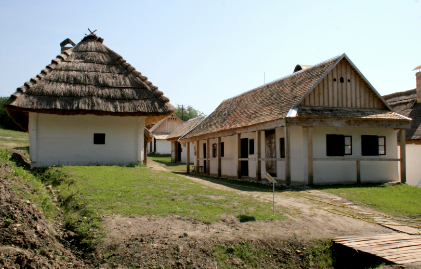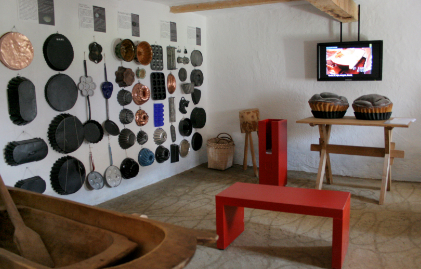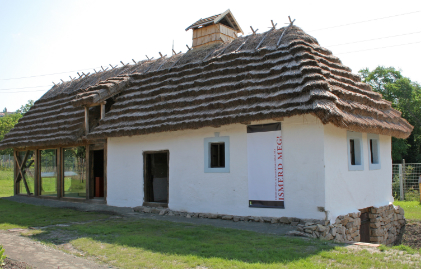Unique exhibition in the Hungarian Open Air Museum, in Szentendre
In June, 2010 a new exhibition unit was opened for the public in the Hungarian Open Air Museum, as the 8th exhibition of the Skanzen which represents the 19th-20th century folk architecture, interiors and way of life of rural Hungary,
| Nagyné Batári Zsuzsanna |
2011-05-16 14:19 |
In June, 2010 a new exhibition unit was opened for the public in the Hungarian Open Air Museum, as the 8th exhibition of the Skanzen which represents the 19th-20th century folk architecture, interiors and way of life of rural Hungary, in small settlement parts. Although presenting the abovementioned factors, the Northern Hungarian Village regional unit is different concerning its scientific concept, situations, exhibition time, interactivity or methods of interpretation.
The concept and its novelties – settlement pattern, architecture, social layers
The original plan was to construct a small village in the form of a roadside settlement, situated in the valley of a stream, where houses stand one by one, next to the road. This is characteristic of the northern part of the country; however, smaller additions have been made.
 One of the most spectacular of these is the construction of the building complex of the manor, involving a huge granary and the servants’ quarters. The former building was designed to host exhibitions, museum pedagogical programs, even concerts, or plays. It is a multifunctional, visitor-friendly area from the inside. The servants’ dwelling consists of four living quarters under one roof – each of which was furnished depicting different eras, thus visitors can take part in a time-travel, getting to know several periods of servants’ history. This is a unique venture, as no similar building can be found in Hungarian open air museums.
One of the most spectacular of these is the construction of the building complex of the manor, involving a huge granary and the servants’ quarters. The former building was designed to host exhibitions, museum pedagogical programs, even concerts, or plays. It is a multifunctional, visitor-friendly area from the inside. The servants’ dwelling consists of four living quarters under one roof – each of which was furnished depicting different eras, thus visitors can take part in a time-travel, getting to know several periods of servants’ history. This is a unique venture, as no similar building can be found in Hungarian open air museums.
Apart from this, there is another kind of building that is special concerning its construction in an open air museum: it is the cave-house, which is originally excavated from the turf. In the museum we applied special, modern building techniques to achieve the characteristic appearance – as in this case, the presentation of interior furnishings and the way of life gains emphasis. We present two types of cave dwellings evoking the period between the two world wars: the first is a one-room edifice, where a basket weaver lives with his family, visitors can see him during his work. The second dwelling has a more sophisticated layout with kitchen – room – pantry – cellar. Here, a seasonal contract labourer lives and the moment we show is the evening before he sets off to work while he is preparing for the journey with the help of his wife, packing his chest and sack.
A significant change concerning the concept of the exhibition is the expansion of sacred monuments. Apart from a Roman Catholic belfry, we realised the construction of a Greek Catholic roadside crucifix and a small chapel with the statue of the Virgin Mary. The latter is from outside the Hungarian border, from the historical Hungarian territory. It is important to incorporate these areas in the research to be able to present an authentic picture of Hungarian folk life from the 19th-20th century. This kind of research is also a special phenomenon in Hungarian open air museology; thanks to this we managed to find a gentry-house in Nemesradnót (Slovakia) we included in the museum village. With the help of this building we can represent the lifestyle of the gentry’s descendants in the 1930s.
Architecturally the exhibition authentically represents the different structures of Northern Hungary, such as stone, log-, timber-framed, brick and adobe walls, thatched, tiled or reed roofs and several types of ovens, chimneys and fireplaces. The yards are complete with outbuildings and there is also a barn enclosure in the outskirts of the museum village and a vineyard with three different types of cellars and two press houses.
With these changes we managed to show the way of life of not just peasants and gentry descendants, but seasonal contract labourers, servants and itinerant workers, such as tinkers or trough makers, making a more vivid picture of the various social layers living in villages.
Situations
 The exhibition is enriched by the situations recalled in the interiors of the houses. This means the presentation of folk customs, moments of everyday life, holidays, household chores in the interiors on the basis of thorough research, so that we can show more from the folk traditions apart from the furnishings and objects. In this way, the presence of the people, of the inhabitants can be imagined more vividly. The represented customs mainly belong to the autumn-winter period, as the exhibition is open in winter time for visitors. Thus visitors can experience the feast after a winter pig-killing in the dwelling of Márianosztra, the spinnery in Karancskeszi, a wedding feast in the house from Perkupa, a family gathering at Christmas in Nemesradnót, the baking of pretzel in the dwelling from Erdőhorváti, the preparation of a huge wedding cake in the dwelling of Novaj, and the abovementioned cave dwellings with basket-weaving and preparation for seasonal contract labour.
The exhibition is enriched by the situations recalled in the interiors of the houses. This means the presentation of folk customs, moments of everyday life, holidays, household chores in the interiors on the basis of thorough research, so that we can show more from the folk traditions apart from the furnishings and objects. In this way, the presence of the people, of the inhabitants can be imagined more vividly. The represented customs mainly belong to the autumn-winter period, as the exhibition is open in winter time for visitors. Thus visitors can experience the feast after a winter pig-killing in the dwelling of Márianosztra, the spinnery in Karancskeszi, a wedding feast in the house from Perkupa, a family gathering at Christmas in Nemesradnót, the baking of pretzel in the dwelling from Erdőhorváti, the preparation of a huge wedding cake in the dwelling of Novaj, and the abovementioned cave dwellings with basket-weaving and preparation for seasonal contract labour.
The dwelling from Domaháza is an interesting museological experiment, as the interior is furnished on the basis of photo documentation by an ethnographer from the 1960s. This was the starting point for the field work, the collection of objects and the reconstruction of the interior. Naturally there were details unseen in the pictures; we made interviews with the living family members to find out the types of objects which were there. We used the old photos in the exhibition; visitors can see them one by one on a computer screen: parallel to this, the interior is lit on the precise spot. Thus people can compare the original and the museum reconstruction. The series of pictures are arranged in a way that they tell a story: the preparation for sleeping, attached to this an audio-material can be heard.
Interpretation, interactivity
 These situations, interiors and necessary special objects may not be so easily understandable for visitors. That is why different tools of interpretation are applied in the exhibitions – such as audio materials, written texts, photos, videos etc. Sometimes these contribute to the creation of a more authentic atmosphere: e. g. in the spinnery or the wedding feast, where original songs and tales can be heard. But let’s see a few more examples! In the spinnery there is a hands-on installation with samples of raw material and homespun linen so that visitors can touch them. Visitors can also have a look at illustrations about spinning and read interesting additional information in connection with the topic with the help of a cupboard-shaped installation. The mass of spinning girls is indicated by authentic necklaces, hanging in the air at the precise spot where they would be sitting.
These situations, interiors and necessary special objects may not be so easily understandable for visitors. That is why different tools of interpretation are applied in the exhibitions – such as audio materials, written texts, photos, videos etc. Sometimes these contribute to the creation of a more authentic atmosphere: e. g. in the spinnery or the wedding feast, where original songs and tales can be heard. But let’s see a few more examples! In the spinnery there is a hands-on installation with samples of raw material and homespun linen so that visitors can touch them. Visitors can also have a look at illustrations about spinning and read interesting additional information in connection with the topic with the help of a cupboard-shaped installation. The mass of spinning girls is indicated by authentic necklaces, hanging in the air at the precise spot where they would be sitting.
People’s presence is symbolised by painted figures on the wall in the house of the wedding feast. While enjoying the view of another dinner in Márianosztra, namely that of the pig killing’s feast visitors can listen to noises of eating. A film can be seen about the baking of the pretzel in the kitchen of the dwelling from Erdőhorváti and also about the preparing of the wedding cake in the pantry of the dwelling from Novaj. This latter place is altogether an interactive space where visitors can touch anything and or see the film and we also organised a small exhibition on the back wall showing different types of baking forms – connected to the topic of baking. This small exhibition is complemented by old recipes people can try out at home. The dwelling house from Filkeháza is also an interactive space, where everything is an authentic replica object or an object of demonstration. Here an interpreter explains daily life and the functions of objects during which anything can be tried. A new phenomenon in the Hungarian Open Air Museum is the application of plastic food, which was important to demonstrate the main topic of the house (mainly when baking is emphasised) in certain cases or help in understanding the function of objects. These plastic pieces are authentic replicas, and do not harm the artefacts.
Exhibitions
 Interiors in the museum village are complemented with small exhibitions, to be able to elaborate on certain subjects and show a wider part of the region’s folk culture in depth. That is why we created a museum cinema in a stable, where visitors can choose among several ethnographical films about the region. Naturally, we can always change the program, which is a great adventure. School groups can take a seat there and watch the films on two screens. Most of the films are shot and directed by us but some of them come from regional television stations or local governments, which helps to involve the region’s inhabitants.
Interiors in the museum village are complemented with small exhibitions, to be able to elaborate on certain subjects and show a wider part of the region’s folk culture in depth. That is why we created a museum cinema in a stable, where visitors can choose among several ethnographical films about the region. Naturally, we can always change the program, which is a great adventure. School groups can take a seat there and watch the films on two screens. Most of the films are shot and directed by us but some of them come from regional television stations or local governments, which helps to involve the region’s inhabitants.
Next to the cinema there is a photo-exhibition, with photos on all the walls from the floor to the ceiling. These photos are grouped according to their place of origin, as they present those villages where dwelling houses came from for the exhibition. We wanted to show people, people’s everyday life and holidays, customs and traditions, costumes and landscape. This way, a more personal view can be formed about these communities and their folk culture. Visitors can search the pictures on two computers in a special database on the basis of numbers in the corner of pictures. Maybe people realise the hidden value of their family albums and take care of the mementos of the past, even offer them for the museum for study. We collected the pictures in museum archives, research centres and naturally, in the villages by knocking on the doors with a notebook and a scanner and ask for help. In the exhibition only the digital copies can be seen, the originals are kept by the owners.
There is an exhibition presenting the life of Hungarians outside the Hungarian borders after World War I. A small exposition is organised to show the famous carvings in different pieces of furniture from the northern part of County Nógrád and Heves.
The greatest exhibition is situated in the second dwelling from Erdőhorváti. It is a methodological exhibition presenting the different methods we use when translocating a house and furnish it with authentic objects. Some of the visitors do not know about the fact that they walk among original buildings and objects. The first part of the exposition focuses on the following topics: selecting a house, numbering the elements, dismantling the building and transporting it to the museum for rebuilding. There is a film about this and people can touch not painted structural parts of the exhibition building too. The question of fireplaces is also emphasised, there is a half-dismantled oven in the kitchen showing what the curators do when doing the research work. Professional advice is also offered on these topics for those who own old buildings. The second part of the exhibition is situated in the reconstructed back part of the house, where there are glass walls to emphasise the fact of reconstruction. Here, visitors can experience how an object is found in e. g. an attic, how it is transported, registered, restored and put into the exhibition. Those interested can become curators and make descriptions of the objects and with the help of a great puzzle furnish an interior. We also put some leaflets inside the exhibition with advice for those who own old objects and computer stations where the topics can be examined in depth with the help of photo documentations, ethnographic descriptions and illustrations.
Summarising the abovementioned, the Northern Hungarian Village regional unit is trying to incorporate much more interactive and special elements so that visitors can understand and enjoy discovering folk culture better.
The leading curator of the exhibition was Nagyné Batári Zsuzsanna, responsible for the interiors, the cinema, the photo collection, the exhibition of benches and the methodological exhibition. The architect of the exhibition was Árpád Román. The curator of the exhibition about Hungarians outside the present-day borders is Lajos Kemecsi. The curator of the servants’ quarters was Kitti Kiss. The ethnobotanical research was carried out by Jakab Lászlóné.